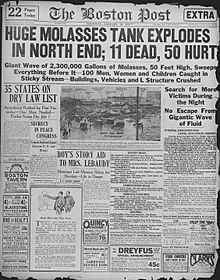One such flood happened on October 17, 1814. In London, England, a huge vat of 135,000 gallons ruptured, causing the contents to flood out and cause damage to other vats, causing them to rupture as well. Total, there was an estimated 323,000 gallons of liquid to flood the streets of the London neighborhood, causing two homes to be destroyed and a wall at a pub to be damaged. The company that had this happen was located in a poorer part of town where entire families lived in basement homes, which quickly filled with the liquid. Eight people are known to have drowned in this flood.
If you noticed, I didn't say what the contents of the vats was, nor did I say what company had this happen. The company was the Meux and Company Brewery, and the vats contained beer. The brewery was taken to court afterwards, but were not found guilty of anything. The company however found it difficult to continue since they lost a lot of beer and the lack of sales afterward. The company continued on despite the incident. The brewery was torn down in 1922; the Dominion Theatre now is on part of that site.
The London Beer Flood (as it's called) isn't the only unusual flood. The other unusual flood occurred on January 15, 1919, in Boston. This flood is called by a few different names, but the one that usually is referred to is the Boston Molasses Disaster. At the time, molasses was the standard sweetener of the US, so it was in high demand. Molasses could also be fermented and turned into rum, but also could be made into ethyl alcohol which is used in other liquors as well as munitions. The demand for molasses was huge at the time. The Purity Distilling Company owned the 50 ft tall and 90 ft diameter container which burst. An estimated 2.3 million gallons of molasses was in the container when it collapsed, shooting rivets as it tore open. A molasses wave as high as 15 feet rushed through the streets at an estimated 35 mph. Trains were lifted from the tracks and buildings were knocked off their foundations. The tragic side is that 21 people died and 150 were injured.
A class action lawsuit was filed against the parent company of Purity Distilling Company, which was called the United States Industrial Alcohol Company. After three years, the USIAC was found to be at fault, and they had to pay $600,000 in settlements (today, that's close to $7 million). Even though the USIAC tried to claim that anarchists blew up the tank, it was found that several events contributed to the collapse. Firstly, the temperature outside was unusually warm for a couple days, causing stress in the metal (temperature went from 2°F to 41°F in two days). Secondly, the tank was constructed poorly and tested inaccurately. Thirdly, fermentation had begun in the tank, causing the pressure to build from expelled carbon dioxide (which was heightened by the increased temperature). Fourthly, the initial problem was at the base of the tank in a manhole cover, where a fatigue crack is believed to have grown to complete the disaster. The tank itself had only been filled to capacity only a few times since it was built, so the walls were put under patterns of stress that weakened it. It was found out later that the original construction of the tank didn't use regular tests such as filling with water to check for leaks. When the tank was filled with molasses, it leaked so badly that it was painted brown to hide the leaks. Locals would sneak up to the tank and fill containers with the leaking molasses. Today, the site of the tank is a recreational park called Langone Park.
 |
| Aftermath of the Boston Molasses Disaster |
Bet you didn't know that!

No comments:
Post a Comment